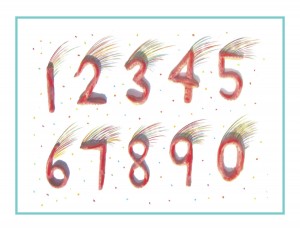Day 7
For one year, 365 days, this blog will address the Common Core Standards from the perspective of creating an alternate, ambient learning environment for math. Ambient is defined as “existing or present on all sides, an all-encompassing atmosphere.” And ambient music is defined as: “Quiet and relaxing with melodies that repeat many times.”
Why ambient? A math teaching style that’s whole and all encompassing, with themes that repeat many times through the years, is most likely to be effective and successful. Today’s blog will focus on the Kindergarten Standard 1 in Operations and Algebraic Thinking. Note that the Common Core Standards will appear in blue, followed by an ambient translation.
Operations and Algebraic Thinking K.OA
Understand addition as putting together and adding to, and understand subtraction as taking apart and taking from.
1. Represent addition and subtraction with objects, fingers, mental images, drawings, sounds (e.g., claps), acting out situations, verbal explanations, expressions, or equations.
Algebraic thinking? Scary thought for Kindergarten. Here’s a little background information. The word algebra is taken from the Arabic “Al Jabr” which means “bone setting.” The Arabic mathematician, Al Khwarizmi (whose name provided us with the math words “algorithm” and “arithmetic”) wrote a book about algebra in the year 830 CE titled, The Science of Restoring What is Missing and Equating Like with Like.
Now as ambitious as the Common Core Standards are, they do not advocate including the algebraic “x” in Kindergarten! But we can view algebraic thinking as simply, equations. The numbers on both sides of the equals sign are, well, equal. Adding, subtracting, and in fact multiplying and dividing could be viewed as operating on numbers to make them equal, to “set their bones” so to speak, to make them whole again.
That said, how do we apply an ambient translation to Standard 1? Actually, this standard is quite ambient in itself. Yesterday’s activity with the counting stones and shells, acorns, etc. could be expanded upon to fit this quite nicely. It would probably be best to keep the adding and subtracting under 10 at first. Here are a few possibilities:
Put the counting stones and objects together to practice addition. For example, put the “3” counting stone to the left of 2 acorns, then count the total out loud using your pointer finger, 1-2-3 4-5, then place the “5” counting stone to the right of the acorns.
To practice subtraction, take a counting stone and cover some of the dots, then place the appropriate stone to the right of it. For example, cover 2 of the 5 dots and say, “5 take away 2,” then point to and count the remaining 3 dots saying, “1-2-3.” Place the “3” counting stone next to the “5” while keeping the 2 dots covered.
As stated in the standard, do use various means of representing the counting. For example, clapping the numbers described above (3 claps -space- 2 claps) could be call and response, with the child(ren) clapping the 5 in response. Try having them jump up and down, or march, or play a small drum or tambourine instead of clapping to represent the counting.
These activities should be as experiential and child-motivated as possible, similar to a Montessori approach. Remember that the optimal mood at this age is playful and joyful, so watch for signs of undue stress and switch to pure play at those times.
Remember that knowledge ensues in an environment dedicated to imaginative, creative knowing, where student and teacher alike surrender to the ensuing of that knowledge as a worthy goal. More Kindergarten tomorrow!












